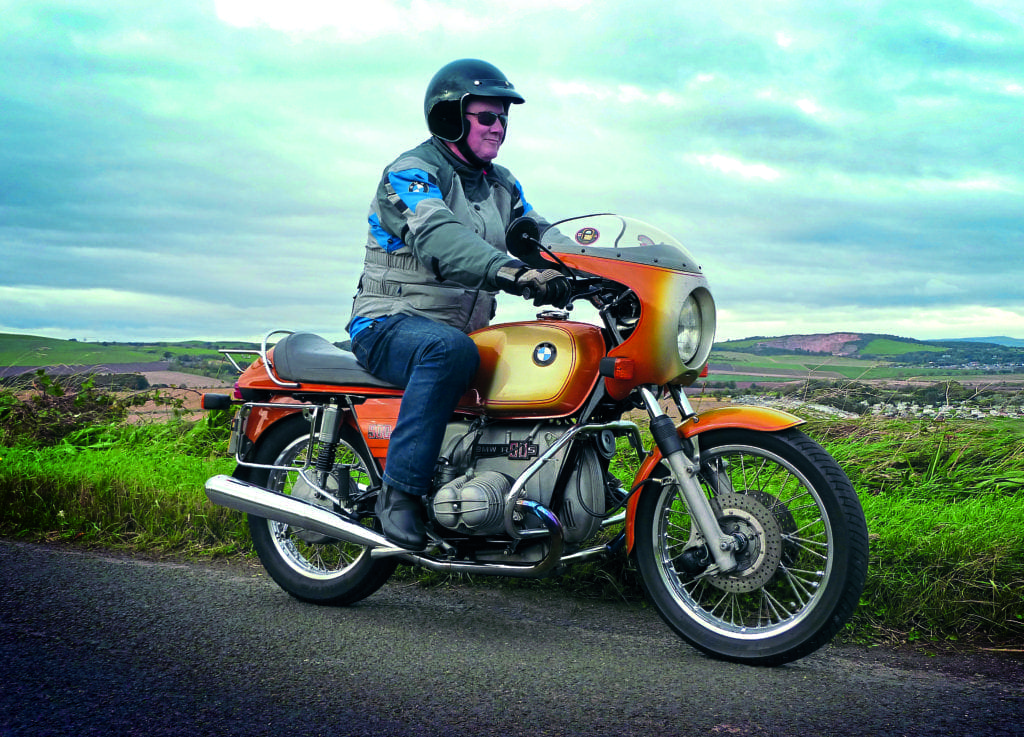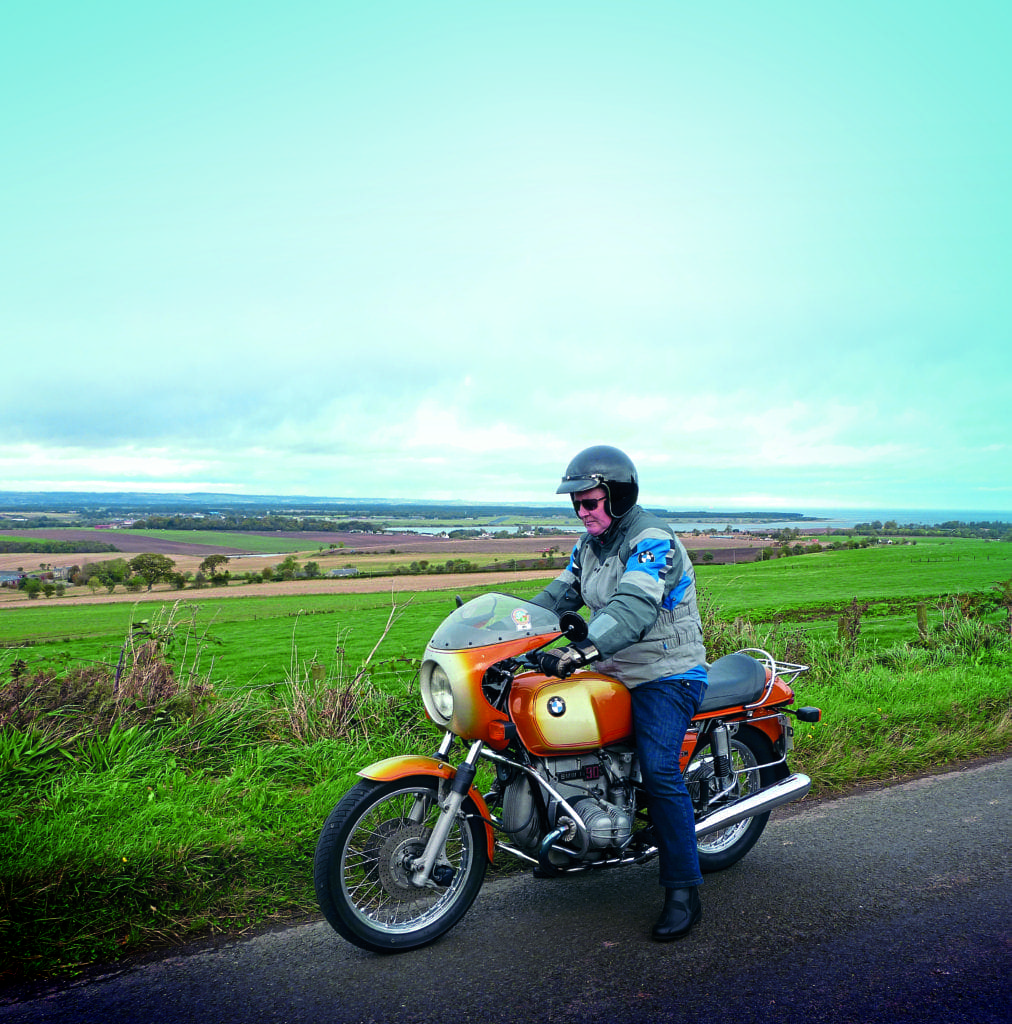It is hard nowadays to believe that during the early Seventies BMW suffered from a poor and staid image. BMWs were well-designed and extremely reliable machines, but they were not seen as the most desirable motorcycles on the planet.

Falling sales became a significant threat to the motorcycle division of BMW’s existence, however, BMW North American sales director, Bob Lutz as well as Suzuki Katana stylist, Hans Muth, came to the rescue by creating the R90S – the bike that turned around BMW’s fortunes. The R90S changed the German marque‘s course, albeit at a price. Owning BMW’s latest and arguably greatest model would set you back a staggering load of beer money when it was launched in 1973. And its high price, £1799 – compared with £585 for a Bonneville – attracted a great deal of flak from the motorcycling press. Costing as much as a small family car, the R90S nevertheless won over critics with its impressive specification and remarkable performance.
Overnight BMW’s flat twin changed from passé to whoopee and justifiably so, because if you could afford it, BMW ownership now meant excitement, adventure and exclusivity. BIKE magazine’s Mark Williams said of the new machine: ‘The man who can afford to buy the new R90S doesn’t want to be concerned with maintenance, but nevertheless he demands mind-zapping power, controllability and, perhaps above all, something out of the ordinary. I think such a man may consider the R90S to be fair value.’
For more content, why don’t you like our Facebook page here, or follow us on Instagram for a snippet of our striking pictures!
Not only did the R90S go on to win public approval, to its credit the BMW won the 1976 Production TT in the able hands of Helmut Dahne. The Beemer was elevated to even higher status when British racer Reg Pridmore won the 1976 AMA Superbike Championship on a R90S, with the model taking first and second podiums at Daytona earlier that year. Another British Champion, Dave Potter also raced a Gus Kuhn BMW R90S endurance bike at Le Mans, the Barcelona 24hrs and at Bol d’Or.
The R90S was bristling with tried and tested German technology and it was no accident that BMW had built a race winner. The new and well engineered 898cc engine was the largest the firm had ever built, with a bore and stroke measuring 90x71mm and a compression ratio of 9.5:1. It produced 67bhp @7200rpm with a (claimed) top speed of 125mph (by contrast, Triumph’s admittedly smaller 750 Bonneville produced 46bhp @6500rpm) and proved to be as reliable as any of BMW’s previous models.

The R90S was fitted with BMW’s new five-speed gearbox, twin front discs, massive accelerator pump Dell’Orto racing carburettors and a completely new cockpit-style half fairing that left no doubts about its sporting intentions. Glowing press reports similar to LJK Setright’s appraisal in BIKE magazine catapulted the R90S into the top league of superbike sales: ‘The detail finish, overall balance, the feel of the controls, the blissful ease of the new five-speed gearbox, and not least the fact that the new R90S can be ridden fast without fatigue, and without having to be refuelled every 50 minutes, all combine to make this an absolutely top-class motorcycle. If I could afford one, I would hesitate no longer.’
Originally launched in two-tone metallic silver-grey the iconic Daytona orange model followed just one year later and is regarded by aficionados as BMW’s most desirable and collectable model.
As well as being an official BMW dealer, Jack Gow was Scottish racing champion in 1967 and 1970. A renowned racer at the IOM TT races he realised his dream by winning the 1995 Classic TT on a 500cc Manx Norton. Jack lost his life the following year, aged just 56, during practice at the Manx TT. The R90S now belongs to Derek Horne and is in totally original condition.
For more content, why don’t you like our Facebook page here, or follow us on Instagram for a snippet of our striking pictures!
During the late Seventies Derek was an ardent racing fan and became a fan of the Daytona orange R90S when it trounced Ducati, Triumph, Norton, Honda and Suzuki to win the Production 1000 Race at Knockhill. “I just couldn’t believe my eyes when this bright orange BMW twin began to carve its way through the field in the 1000cc production race.
“Nothing could touch it for straight-line speed and even around the tight circuit that is Knockhill – the BMW swept everything aside. I knew I had to have one!’’ laughed Derek.
Derek bought his R90S from a friend in 1987 for £1250 – ‘a substantial amount of money back then’, Derek assured me. Today his R90S still looks brand new and its mint condition is quite astonishing considering it has covered more than 48000 miles. His R90S also records four owners (including Derek), and has lived all of its 42 years in and around Dundee. Thirty of those years have been in Derek’s cosseted care – and I can confirm that his R90S looks better in the flesh than it does in the photographs!

“The bike’s first three owners did very little work to the R90S, but it is A BMW!’’ Derek was careful to emphasise. “The first owner took the bike on a long trip to the FIM Rally in Romania and during my 30 years of ownership I have racked up the mileage with tours throughout Scotland and the rest of the UK. It has also has won countless awards at local shows – including several for ‘Best Bike in Original Condition’ at VMCC events. In fact the older it gets, the better this R90’s immaculate looks are appreciated. However, as I notched up the miles, even the world’s most reliable motorcycle began to require some TLC.
Unfortunately after 40k miles, some Bavarian twins are known to drop their exhaust valves. So rather than cross my fingers when I reached this heady milestone, I had the top end overhauled by renowned engineer Simon Linford. After cutting the valve seats, Simon also added new guides, valves, springs and collets. He also honed the barrels and fitted new piston rings. During this time I decided to add progressive fork springs to calm the BMW’s excessive front end dive. The front forks have eight inches of travel and the R90S’s powerful twin discs tend to swallow this up during heavy braking.
For more content, why don’t you like our Facebook page here, or follow us on Instagram for a snippet of our striking pictures!
Other age-related problems on BMWs are rotting seat bases and rusting battery carriers, both of which had suffered on my machine. So the original seat base was primed and painted before being recovered by BMW expert Keith Shaw. The rusty battery box was blasted back to bare metal, primed and then powder coated for longevity’s sake. The starter relay suddenly failed but once I replaced it, normal starting resumed. At the time I also added a Boyer electronic ignition system and it has never let me down. The original factory paintwork is largely unflawed and only the odd stone chip spoils the durable BMW finish. I have owned many different brands of motorcycles and in my experience the quality and finish of BMWs is second to none.’’ Derek concluded.
“After watching the new R90S winning production races at home and abroad I became very impressed with their sporting potential. There was also the harsh reality that BMWs simply outclassed any British bikes of the era. The factory’s fame for outstanding reliability and quality engineering was also hard to ignore, particularly when my British Bonneville appeared unrefined by comparison, and vibrated and leaked oil from just about every joint. Maintenance-free shaft drive was another attraction, principally because I was weaned on Duckhams Link-Life and the potentially dangerous practice of boiling a chain over an open gas stove in the middle of your garage. You would hang the hot and dripping chain on a rusty old nail to drip-dry before you faced the messy job of refitting it – small wonder that servicing the chain was a largely ignored task. It makes me laugh to think that’s just the way it was before BMWs appeared on my horizon.
I often had my nose pressed up against Jack Gow’s showroom window just dreaming of riding a BMW. I had the opportunity to test one when a friend offered me a ride on his brand new R90S – he was a very good friend! The smooth engine’s relentless torque was a sensation and the stunning looks just blew me away. The finish is also top class and I was delighted to learn that every machine on the Bayerische Motoren Werke production line was signed off by its final assembly line worker. This valued employee’s signature can be found inside the right-side cockpit fairing adjacent to the headlight mounting. What a brilliant touch!’’ beamed Derek.
Want to read on? Then subscribe to Classic Bike Guide and read our magazines online!
For more content, why don’t you like our Facebook page here, or follow us on Instagram for a snippet of our striking pictures!




